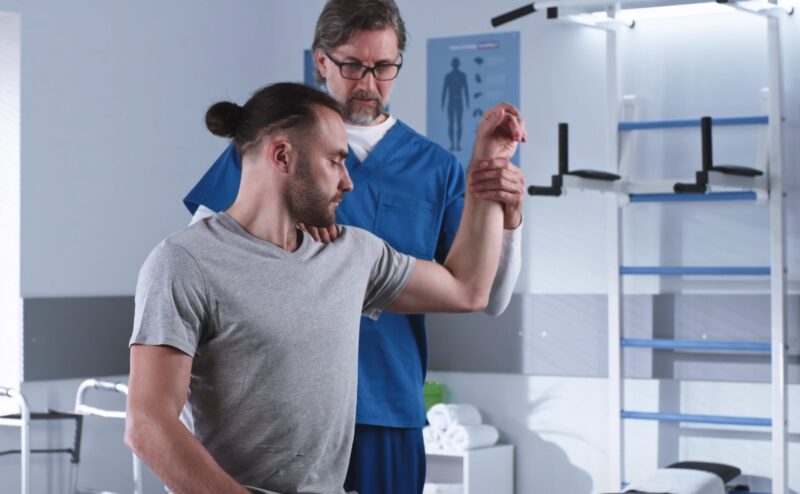Have you ever wondered what it takes to become a chiropractor? Chiropractic education is a blend of theoretical knowledge and practical training. It’s designed to equip students with the skills needed to diagnose, treat, and prevent musculoskeletal system disorders.
In this post, we’ll explore the duration and depth of chiropractic schooling, offering insights into what aspiring chiropractors can expect.
Key Takeaways
- A bachelor’s degree usually takes about four years.
- Subjects like biology, chemistry, physics, and psychology are crucial during the pre-chiropractic phase.
- Human anatomy and physiology are recommended or required due to their direct relevance to chiropractic studies.
- Volunteering or shadowing in healthcare settings, especially in chiropractic offices, is beneficial.
- The specialized chiropractic program typically spans another four years.
Chiropractic School Duration
Chiropractic programs generally span four years. The curriculum is divided into two phases:
1. Theoretical Learning
In the first two years, students dive into courses like anatomy, physiology, and pathology. This phase lays the foundation for understanding the complexities of the human body, essential for effective chiropractic care.
Courses in anatomy delve deep into the musculoskeletal system, crucial for understanding spinal adjustments. Physiology classes teach how the body functions normally, helping students recognize abnormalities. Pathology introduces students to various diseases, preparing them to diagnose and treat spinal and musculoskeletal disorders.
2. Clinical Practice

The last two years focus on hands-on training in clinical settings. Here, students apply their theoretical knowledge in real-life scenarios, learning how to manage patient care effectively. They practice spinal adjustments under supervision, honing their skills in this critical area of chiropractic care.
These years also emphasize developing communication skills, vital for patient interactions. Clinical rotations cover various specialties, offering broad exposure to different aspects of chiropractic treatment.
Accreditation and Licensing
Post-graduation, chiropractors must pass national and state licensing exams to practice. These exams test their knowledge and skills, ensuring they meet the professional standards required for safe and effective practice.
The licensing process also includes an ethics examination, emphasizing the profession’s commitment to high moral standards. Continuing education is often required to maintain licensure, ensuring chiropractors stay updated with the latest advancements in the field.
The Curriculum

| Year | Focus Area | Course/Activity | Description |
|---|---|---|---|
| 1-2 | Foundational Sciences | Anatomy | Detailed study of the human body, including the skeletal, muscular, and nervous systems. Labs and dissections provide hands-on experience. |
| Physiology | Study of how the body functions under normal conditions. Focuses on the nervous system and its interaction with the musculoskeletal system. | ||
| Biochemistry | Learning about the chemical processes within the body, and how chemicals and hormones affect health. Crucial for holistic wellness approaches. | ||
| 3-4 | Clinical Skills and Practice | Adjustment Techniques | Learning various spinal manipulation techniques, focusing on safety, effectiveness, and appropriateness for different conditions. |
| Patient Care | Developing patient management skills, including treatment planning, communication, and education. Emphasizes holistic care considering overall health and lifestyle. | ||
| Internships | Gaining real-world experience in clinics, working with experienced chiropractors and diverse patient populations. |
Continuing Education

Chiropractors often engage in continuing education to stay updated with advancements in the field. This ongoing learning is not only a requirement for maintaining licensure but is also vital for staying abreast of the latest techniques, research, and treatments in chiropractic care.
Continuing education can take various forms, including seminars, workshops, online courses, and attending professional conferences. These educational opportunities often cover new and evolving areas such as integrative medicine, technological advancements in treatment, and updates in healthcare regulations.
Moreover, continuous education ensures that chiropractors can offer the most effective and current care to their patients, reinforcing their commitment to high standards of practice and patient safety.
Specialized Programs
A specialized chiropractic program offers in-depth training in specific areas like sports medicine, pediatric care, or orthopedics. These programs, integrated into standard chiropractic education, allow students to focus on particular niches, combining advanced coursework with practical training.
Specializations provide targeted clinical experience through internships, enhancing skills in treating specific patient groups. Graduates emerge with both general chiropractic knowledge and expertise in their chosen area, opening doors to niche healthcare roles and greater professional opportunities.
Pre-Chiropractic Education

Before entering chiropractic school, students typically need a bachelor’s degree, often with a focus on science-based courses. This pre-chiropractic phase can take about four years.
During this time, students are encouraged to concentrate on subjects like biology, chemistry, physics, and psychology, which provide a solid foundation for the advanced chiropractic curriculum.
Additionally, many programs recommend or require courses in human anatomy and physiology, as these areas are directly relevant to chiropractic studies. Gaining experience through volunteer or shadowing opportunities in healthcare settings, particularly in chiropractic offices, can also be beneficial for prospective students.
This not only strengthens their application but also provides valuable insight into the chiropractic profession, helping them make an informed decision about their career path.
FAQs
Can a student specialize in a particular area of chiropractic care during their education?
Yes, students can often choose to specialize in areas such as sports medicine, pediatric care, or geriatric care during their chiropractic education.
Are there any online programs available for pre-chiropractic education?
Yes, some universities offer online courses or programs for the pre-chiropractic phase, but it’s important to ensure these are accredited and meet the prerequisites for chiropractic school.
Is a background in sports or physical therapy advantageous for chiropractic students?
A background in sports or physical therapy can be advantageous as it provides a practical understanding of the musculoskeletal system and patient care, which are relevant to chiropractic studies.
Are there scholarships or financial aid options available for chiropractic students?
Many chiropractic schools and external organizations offer scholarships and financial aid for students. It’s advisable to research and apply early for these opportunities.
How important is hands-on clinical experience during chiropractic education?
Hands-on clinical experience is crucial as it allows students to apply their theoretical knowledge in real-world settings and develop practical skills essential for their future practice.
Can chiropractic students conduct research during their program?
Yes, many programs encourage or even require research projects, allowing students to contribute to the field’s body of knowledge and gain valuable research experience.
Final Thoughts
Becoming a chiropractor involves extensive education and training. Starting with a four-year undergraduate program focused on science-based courses, aspiring chiropractors build a strong foundational knowledge before a specialized four-year chiropractic program.
This rigorous educational pathway ensures that chiropractors are well-prepared with both theoretical knowledge and practical skills to provide effective care to their patients.
